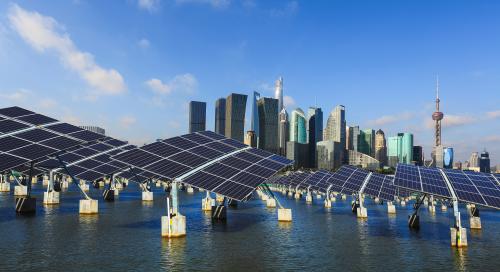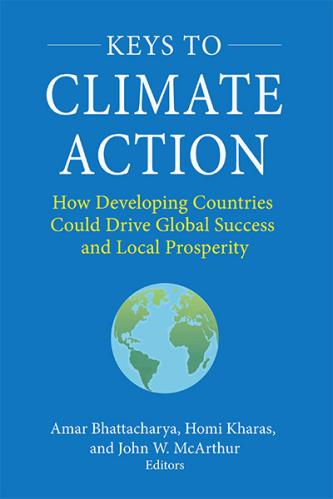The global debate around climate change is heated. Many argue that we must fundamentally change the way we move, eat, fuel our factories, and heat and cool our homes. And they do so with reason. Should emissions evolve in line with past trends, we are set to exceed the GHG concentration levels consistent with the 1.5-degree target of the Paris Agreement already by 2031, according to projections by World Data Lab’s World Emissions Clock.
Can humanity change fast enough to escape this fate? Can richer countries break unsustainable patterns? What about emerging markets whose emissions are still growing as they continue to expand their economies? To answer these questions, we must take a surgical view of emissions by country and sector, and look at projections on how they will evolve.
Rich countries alone cannot solve the problem
Climate change is often viewed as a problem for wealthier countries to solve. While it is mainly developed countries that are responsible for the emissions of the past, they alone cannot solve this problem because today they are only responsible for a quarter of global emissions. Even if all OECD economies eliminated their emissions today, the Paris Agreement goals would not be met (Figure 1).
Figure 1. What would happen if OECD countries dropped their emissions to zero now?
Source: World Data Lab, World Emissions Clock
Over the past 20 years, OECD countries reduced emissions by some 11 percent (albeit from a very high base) and they are projected to emit 14.3GT in 2023 (25 percent of global emissions). This means that 75 percent of global emissions are now originating in emerging and frontier markets. Without corrective action, emissions in these countries would further grow from 43GT to 48GT by 2030; in 2023, out of the top 10 emitters, only three are likely to be from the OECD: the USA, Japan and Canada (see figure 2).
Figure 2. The top GHG emitters of the world are mostly from emerging markets
Source: World Data Lab, World Emissions Clock
Going ‘surgical’ on country emissions
On average, an OECD citizen emits 12.4 tons of greenhouse gases (in CO2 equivalents), which is around 70 percent above the world average of 7.4 tons per capita. If we look deeply into the emissions by country or region, we find some surprising facts:
- Europe “only” contributes 11 percent of global emissions, of which 6 percent are caused by EU countries. This is still too high as Europe represents just 9 percent of the global population.
- North American emissions per capita are the highest in the world. It is not the average United States citizen who emits the most at annually 19 tons per capita, but Canadians, with almost 24 tons per capita.
- Asia accounts for 55 percent of the world’s emissions (China alone is emitting 25 percent), a share that increases even further in a business-as-usual scenario until 2030 due to Asia’s rapid economic growth. Although this is still slightly below Asia’s share of the global population of 60 percent, the bulk of climate action, including financing the transition, must be directed toward Asian countries.
- Africa’s countries contribute less than 10 percent of today’s emissions, despite having 17 percent of the world’s population. With growing living standards and population, they are projected to have the fastest rise in GHG emissions. Africa is also the poorest continent. Having international support for decarbonizing their production chains should be a priority.
How can we achieve lower emissions while maintaining economic growth?
Developing countries have made clear that they cannot take on ambitious emission reduction targets unless they can simultaneously accelerate growth in the living standards of their population. Yet, it is possible to prosper with low emissions. Today, emissions per capita vary enormously among high-income countries. Australian GHG emissions per capita are more than threefold Sweden’s, though both countries have roughly the same per-capita income level. Therefore, it is helpful to examine the success stories—countries that have low carbon intensity and high living standards. With the data from the World Emissions Clock, we can build a combination of best practices across OECD countries. In the best possible scenario of the rich world, the level of emissions would decline to only 3.3 tons per capita—less than half of the world average and only around 20% of the per-capita emission of the U.S.. This best combination would include the following country-sector combinations:
- For energy systems, the best country is Switzerland emitting only 0.5 tons per capita per year relying mostly on nuclear and hydro generation.
- For Industry, one OECD country with relatively low emissions is the UK, whose economy is fueled by a strong service sector. However, its strong decarbonization strategy including carbon pricing, fuel switching, and carbon leakage mitigation contributed to industry emissions as low as 1 ton per capita
- Transport remains a challenging sector as very few OECD countries have managed the low-carbon transition yet. However, the Netherlands with 1.8 tons per capita is a better performer, helped by electric passenger trains using green energy, a sustainable fuel mix policy, a rapid expansion of EV infrastructure, and a priority on biking in cities.
- In Agriculture (including land-use change), South Korea is a world leader. Its strong reforestation programs and lower-emissions rice production have brought its net agricultural emissions to -0.4 tons per capita, i.e., absorbing CO2 instead of adding to it.
- For Buildings, Sweden stands out as its low-energy building standards, including thick insulation and triple glazing for several decades, have resulted in per capita emissions as low as 0.2 tons.
If these five countries keep their promises, by 2030, and each OECD country adopted the best-sector technology from their peers, then OECD per-capita emissions would fall to only 2.2 tons. This would be 50 percent lower than the implied per-capita target of the Paris agreement of 3.6 tons. Despite what you see in the headlines, it is possible to grow rich and minimize emissions. We just need to learn from today’s best examples.










Commentary
Building a prosperous world with fewer emissions
April 13, 2023